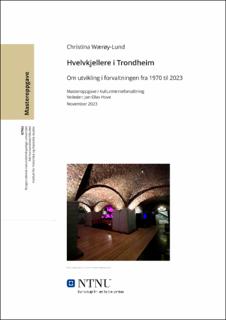| dc.contributor.advisor | Hove, Jon Olav | |
| dc.contributor.author | Wærøy-Lund, Christina | |
| dc.date.accessioned | 2024-01-05T18:19:51Z | |
| dc.date.available | 2024-01-05T18:19:51Z | |
| dc.date.issued | 2023 | |
| dc.identifier | no.ntnu:inspera:155606967:27011216 | |
| dc.identifier.uri | https://hdl.handle.net/11250/3110236 | |
| dc.description.abstract | I nesten 400 år har hvelvkjellere vært en sentral del av Trondheims historie. De ble bygget for å tjene som brannsikring i en brannutsatt treby. De eldste profane hvelvkjellerne i Trondheim stammer tilbake til bybrannen i 1651. I dagens samfunn tjener de gjerne andre oppgaver enn de ble bygget for, og dette har skapt diskusjon i forvaltningen.
Denne oppgaven tar for deg utviklingen av vernetanken i forvaltningen fra 1970 til 2023 med fokus på hvelvkjellere. Spørsmål oppgaven stiller er i hvilken grad hvelvkjellere har blitt vernet gjennom perioden og hvordan vernet har utviklet seg. Oppgaven vil videre svare på tre underspørsmål som dreier seg om hvilke muligheter forvaltningen har hatt til å verne hvelvkjellere, hvordan verneverdier har blitt vektet i forvaltningen samt hvordan forholdet mellom eiere av hvelvkjellere og forvaltningen har vært.
Det er gjort undersøkelser i en rekke byggesaker av syv hvelvkjellere som beskriver hvordan vernetanken har utviklet seg fra 1970 og frem til 2023.
Oppgaven består av 5 hoveddeler inkludert innledning med problemstillinger, relevant teori og metode. Del to tar for seg hvelvkjellernes utforming, historie og bruk. Del tre og fire er oppgavens hoveddel. I del tre blir case studiene presentert og i del fire blir hvelvkjellernes vern per 2023 drøftet. Til slutt undersøker jeg hvordan forvaltningen har gått fra samarbeid med eiere til en sterkere kommunal styring. I del 6 er det konklusjon der jeg svarer på hvordan denne utviklingen har vært. | |
| dc.description.abstract | For almost 400 years, vaulted cellars have been a central part of Trondheim's history. They were built to serve as fire protection in a fire-prone city. The oldest known profane vaulted cellars in Trondheim date back to the city fire in 1651. In today's society, they often serve other tasks than they were built for, and this has caused discussion in the administration.
This thesis deals with the development of the conservation concept in public management from 1970 to 2023, and how the administration has viewed the vaulted cellars as cultural heritage. The question the thesis asks is to what extent vaulted cellars have been protected throughout the period and how the protection has developed. The assignment will further answer three sub-questions which concern what opportunities the administration has had to protect vaulted cellars, how conservation values have been weighted in the administration and what the relationship between owners of these vaulted cellars and the administration has been like.
The thesis have researched a number of construction cases, consisting of seven vaulted cellars which describe how the conservation thought has developed from 1970 until 2023.
The assignment consists of 5 main parts including an introduction with issues, relevant theory and method. Part two deals with the vaulted cellars' design, history and use. In part three, the case studies is presented and in part four, the vaulted cellars' protection as cultural heritage as of 2023 is discussed. Finally, I examine how the administration has gone from cooperation with owners to stronger municipal governance. In part 6 I conclude and answer the issues and how this development has taken form. | |
| dc.language | nob | |
| dc.publisher | NTNU | |
| dc.title | Hvelvkjellere i Trondheim. Om utvikling i forvaltningen fra 1970 til 2023 | |
| dc.type | Master thesis | |
